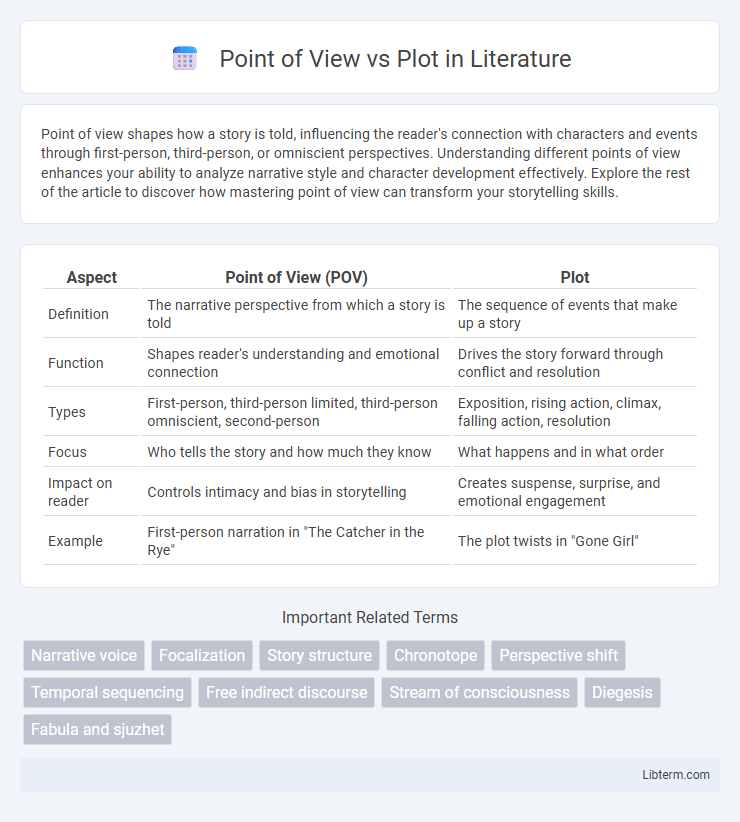Point of view shapes how a story is told, influencing the reader's connection with characters and events through first-person, third-person, or omniscient perspectives. Understanding different points of view enhances your ability to analyze narrative style and character development effectively. Explore the rest of the article to discover how mastering point of view can transform your storytelling skills.
Table of Comparison
| Aspect | Point of View (POV) | Plot |
|---|---|---|
| Definition | The narrative perspective from which a story is told | The sequence of events that make up a story |
| Function | Shapes reader's understanding and emotional connection | Drives the story forward through conflict and resolution |
| Types | First-person, third-person limited, third-person omniscient, second-person | Exposition, rising action, climax, falling action, resolution |
| Focus | Who tells the story and how much they know | What happens and in what order |
| Impact on reader | Controls intimacy and bias in storytelling | Creates suspense, surprise, and emotional engagement |
| Example | First-person narration in "The Catcher in the Rye" | The plot twists in "Gone Girl" |
Understanding Point of View
Understanding point of view is essential for interpreting a narrative's perspective and emotional depth, as it determines who is telling the story and how events are perceived. Point of view influences the reader's connection with characters and shapes the delivery of plot information, affecting clarity and reliability. Mastering different points of view, such as first-person, third-person limited, and omniscient, enhances a writer's ability to control narrative focus and thematic emphasis.
Defining Plot in Storytelling
Plot in storytelling refers to the structured sequence of events that unfold within a narrative, driving the story forward through conflict, climax, and resolution. It is the framework that organizes actions and causes, establishing relationships between characters and events to create coherence. Unlike point of view, which determines the perspective from which the story is told, plot focuses on what happens and how the events interconnect to maintain suspense and engagement.
Types of Narrative Perspectives
Types of narrative perspectives include first-person, second-person, and third-person points of view, each shaping how readers experience the plot. First-person offers an intimate, subjective view through a character's eyes, while third-person can be limited, omniscient, or objective, controlling the amount of information revealed. Choosing the narrative perspective directly influences the plot's delivery, pacing, and the emotional connection between readers and characters.
How Point of View Shapes the Reader’s Experience
Point of view (POV) profoundly shapes the reader's experience by controlling the lens through which the story unfolds, directly influencing the emotional connection and insight into characters' thoughts and motivations. First-person POV creates intimacy and immediacy, immersing readers in the narrator's subjective reality, while third-person limited offers selective insight that balances character depth and narrative flexibility. The choice of POV determines how plot events are revealed, driving suspense, reliability, and reader engagement throughout the storyline.
The Role of Plot in Story Development
Plot serves as the structural framework that drives story development by organizing events in a purposeful sequence, creating conflict, and building suspense. It acts as the backbone of narrative progression, guiding character actions and decisions while maintaining coherence and momentum throughout the story. The plot's design directly influences pacing and emotional engagement, shaping the reader's experience and understanding of the thematic elements.
Interplay Between Point of View and Plot
The interplay between point of view and plot shapes the narrative's depth, as the chosen perspective influences how events unfold and reveal information to the reader. A first-person point of view offers intimate access to the protagonist's emotions and biases, directly impacting plot tension and character development. Shifts in point of view can create dramatic irony or suspense, driving the plot forward through varied perceptions and subjective interpretations.
Examples of Point of View Influencing Plot
The choice of point of view (POV) directly shapes the plot by controlling the flow of information and reader engagement, as seen in Harper Lee's *To Kill a Mockingbird*, where Scout Finch's first-person narration provides a child's perspective that influences the unfolding of moral and social themes. In contrast, George R.R. Martin's *A Game of Thrones* employs multiple third-person limited POVs, allowing the plot to expand through various characters' experiences and motives, creating a complex, multi-threaded narrative. This manipulation of POV strategically guides the plot's direction, suspense, and character development.
Common Mistakes in Handling Point of View and Plot
Common mistakes in handling point of view (POV) and plot include inconsistent shifts in narrative perspective that confuse readers and disrupt story flow. Authors often neglect the alignment between POV and plot development, resulting in scenes where character insight or emotional impact is diminished. Overusing multiple POVs without clear transitions can weaken plot coherence and reduce reader engagement.
Tips for Balancing Point of View and Plot
Balancing point of view and plot requires maintaining consistent narrative perspective while advancing the story's events to keep readers engaged. Use limited point of view to create intimacy and suspense, but shift viewpoints strategically to reveal key plot developments or character insights without confusing the audience. Employ clear transitions and anchor emotional beats within the plot's progression to ensure that character perspectives enhance rather than overshadow the storyline.
Enhancing Your Story with the Right Perspective and Structure
Choosing the appropriate point of view (POV) shapes readers' connection to characters by controlling how much internal thought is revealed, while the plot determines the sequence of events that drive the narrative forward. Enhancing your story requires aligning the POV with the plot's structure to create a cohesive flow that intensifies tension and emotional impact. For example, a first-person POV offers intimate access to the protagonist's mindset, deepening suspense in a nonlinear plot, whereas a third-person omniscient viewpoint allows for broader story arcs and multiple character perspectives within a traditional three-act structure.
Point of View Infographic

 libterm.com
libterm.com